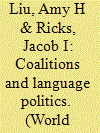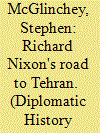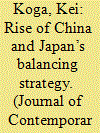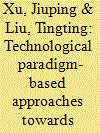|
|
|
Sort Order |
|
|
|
Items / Page
|
|
|
|
|
|
|
| Srl | Item |
| 1 |
ID:
114497


|
|
|
|
|
| Publication |
2012.
|
| Summary/Abstract |
Why is it that some governments recognize only one language while others espouse multilingualism? Related, why are some governments able to shift language policies, and if there is a shift, what explains the direction? In this article, the authors argue that these choices are the product of coalitional constraints facing the government during critical junctures in history. During times of political change in the state-building process, the effective threat of an alternate linguistic group determines the emergent language policy. If the threat is low, the government moves toward monolingual policies. As the threat increases, however, the government is forced to co-opt the alternate linguistic group by shifting the policy toward a greater degree of multilingualism. The authors test this argument by examining the language policies for government services and the education system in three Southeast Asian countries (Singapore, Malaysia, and Thailand).
|
|
|
|
|
|
|
|
|
|
|
|
|
|
|
|
| 2 |
ID:
131453


|
|
|
|
|
| Publication |
2013.
|
| Summary/Abstract |
By the time of Richard Nixon's arrival in office Iran had already become America's single largest arms purchaser. This was the result of an evolutionary process that had been underway for two decades. Nixon did not just change that evolutionary pattern of arms sales with Iran, he completely revised U.S. thinking on Iran's regional role. By the end of his first term in office, Nixon had leveraged U.S. Middle Eastern regional policy primarily around the focal point of a militarily strong, pro-U.S. Iran. In concert, the shah was encouraged to begin an unprecedented military spending spree. Consequently, in mid-1972 following a meeting of the two leaders in Tehran, Iranian annual purchases went, virtually overnight, from being measured in the tens of millions to being measured in the multi-billions. Tracing the complex evolution toward that meeting, and the accompanying policy shifts, form an underappreciated part of Cold War history.
|
|
|
|
|
|
|
|
|
|
|
|
|
|
|
|
| 3 |
ID:
147609


|
|
|
|
|
| Summary/Abstract |
This article argues that as opposed to the conventional wisdom of Japan’s hedging policy, Japan has been constantly taking balancing behavior vis-à-vis China since the end of the Cold War; however, the incremental shift to explicit balancing began after the 2010 Senkaku Boat Collision Incident. The shift was accelerated by the 2012 Japanese Government Purchase of the Senkaku Islands. Since then, Japan has attempted to engage in both internal and external balancing by taking more security burden-sharing with the United States through the relaxation of Japan’s constitutional and political constraints on its military capabilities and the enhancement of security linkages with other regional states, such as Australia and India.
|
|
|
|
|
|
|
|
|
|
|
|
|
|
|
|
| 4 |
ID:
176820


|
|
|
|
|
| Summary/Abstract |
Wind energy has gained significant support to be one of the primary sources of near-zero-emission energy systems. Based on the technological paradigm theory and employing a novel data analysis system (DAS), this paper provides an overview of wind energy technological developments. With key energy law and policy decisions highlighted, the visualization process clearly identified the three technological paradigmatic stages; competition, diffusion and shift; from which it is found that wind-based hybrid energy systems appear to give better promising trajectory in the future than wind energy technologies that rely only on onshore or offshore winds. However, with market maturation, the challenges associated with increasing share, energy storage, motivational conflicts, demand responses and optimal scheduling emerge and are expected to be resolved. From the paradigm shift investigation, a comprehensive sustainable framework for a six-stage hybrid wind-photovoltaic energy system is proposed. Recommendations on policy shifts to encourage technological innovation, regional differentiation, improve monitoring & evaluation systems and the implementation of smart grid are also given to address the incentives that need to be provided.
|
|
|
|
|
|
|
|
|
|
|
|
|
|
|
|
|
|
|
|
|